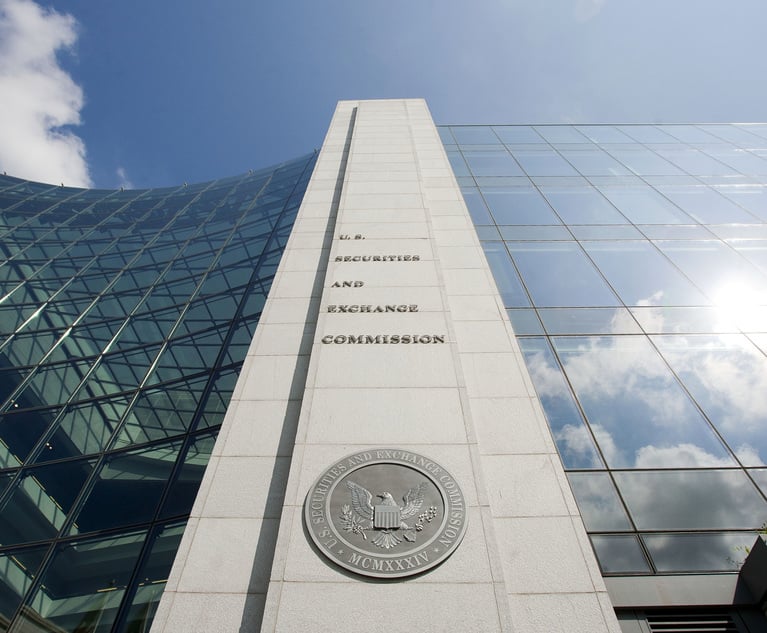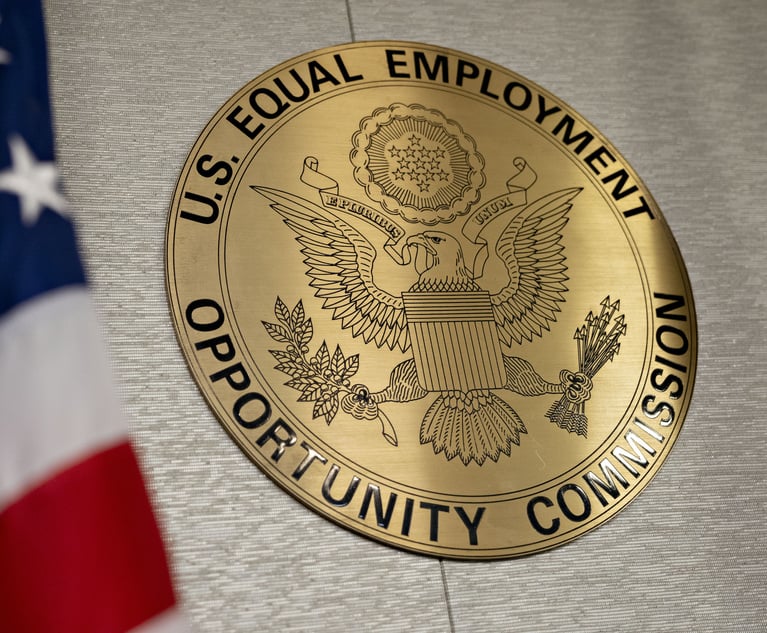Litigation: <i>Tribune Corp.</i> highlights LBO risks for tendering shareholders
A spate of recent litigation has signaled that the predictable LBO benefits traditionally available to tendering shareholders may be in jeopardy.
October 31, 2013 at 04:00 AM
5 minute read
The original version of this story was published on Law.com
With interest rates at historic lows, and the economy slowly strengthening, leveraged buyouts (LBOs) remain a popular means of corporate recapitalization. Whether initiated by private equity sponsors or company founders and insiders, LBO transactions permit the corporation to reconfigure, streamline and improve its business outside the glare of the public company spotlight. Moreover, LBOs present an opportunity for public company shareholders: sale of their company stock to the LBO sponsors at a premium, without assuming further risk associated with the transaction or the now-private company.
But a spate of recent litigation has signaled that the predictable LBO benefits traditionally available to tendering shareholders may be in jeopardy. Typically, if a LBO results in a near-term insolvency of the subject company, sponsors of the LBO – those primarily responsible for engineering the deal – face potential liability. But now plaintiffs, including the company itself (in the form of a bankruptcy or litigation trustee), as well as individual creditors, have brought constructive fraudulent conveyance claims against the “innocent” public company shareholders who sold their stock in the LBO. These claims allege that, even in the absence of any intent to defraud, by tendering stock in the LBO the shareholder received too much value for their company stock. Accordingly, the theory goes, these shareholders are the beneficiaries of a fraudulent conveyance which the lawsuit seeks to recoup.
A recent decision in In re Tribune Fraudulent Conveyance Litigation, a multi-district litigation consolidated in the United States District Court for the Southern District of New York, has provided the most comprehensive examination of the issue to date.
The Tribune LBO and subsequent litigation
In 2007, the board of directors of Tribune Company approved a buy-out plan proposed by private equity investor Samuel Zell. In a two-step transaction, Tribune bought the common stock of Tribune's tens of thousands of public shareholders at a premium, transferring in excess of $8.2 billion to those shareholders. Approximately a year later, in December 2008, Tribune and its subsidiaries filed for bankruptcy protection.
In November 2010, the Tribune creditor's committee filed an adversary proceeding in the Tribune bankruptcy asserting claims against Zell as well as Tribune's officers, directors, and financial advisors. The committee also sought to avoid all LBO-related payments to Tribune shareholders on the basis that the payments constituted intentional fraudulent transfers. The committee did not assert a claim for constructive fraudulent conveyance. (See Official Comm. Of Unsecured Creditors of Tribune Co., et al., v. Fitzsimons.) But within a year, several Tribune individual creditors began commencing dozens of actions against Tribune's thousands of individual and institutional former shareholders, asserting constructive fraudulent conveyance claims brought under state law (the “Individual Creditor Actions”).
Upon consolidation of the cases in the S.D.N.Y., the shareholder-defendants moved to dismiss the Individual Creditor Actions in their entirety. The motion to dismiss made two primary arguments. First, the defendants argued that constructive fraudulent conveyance claims are precluded by Section 546(e) of the Bankruptcy Code, which prevents the avoidance of “settlement payments” for the sale of securities absent a showing that the payment was intended to “hinder, delay, or defraud creditors” – in other words an intentional fraudulent conveyance. Second, defendants argued that the Individual Creditors did not have standing to bring any fraudulent conveyance claims absent the committee's (later a litigation trustee's) renunciation of those claims.
The court's decision
On Sept. 23, 2013, the court dismissed the Individual Creditor Actions. The court held that individual creditors were precluded from asserting claims for intentional or fraudulent transfers so long as the trustee was also exercising its avoidance powers in the bankruptcy.
However, and critically for tendering LBO shareholders, the Tribune court rejected defendants' argument that Section 546(e) preempted the creditors' claims. The court found no basis in the text of Section 546(e) to evidence Congress' intent to bar state law constructive fraudulent conveyance claims. While the Court recognized that Section 546(e) is designed to create finality in securities transactions, the Court held that in the right context, the constructive fraudulent conveyance claim – requiring no showing of fraudulent intent at all – may be alive and well, and not precluded by the traditional “settlement payments” exception.
Lingering uncertainty for tendering shareholders
The court's rejection of defendants' Section 546(e) preemption argument leaves open the question of whether, and in which contexts, creditors will be able to pursue state law constructive fraudulent conveyance claims outside of bankruptcy. But the immediate implications are quite troubling. Tendering shareholders in an LBO cannot be certain that years after they sell their company stock (in a transaction they had no role in designing, and for a price they had no say in setting), company creditors will not seek to undo the transaction. Until courts provide further clarity, or Congress acts to revise Section 546(e) to expressly preclude them, it is certain that creditors will look towards new and creative ways to assert constructive fraudulent conveyance claims. By doing so, creditors can hope to effectively unwind the LBO, while freeing themselves from the burden of actually pleading and proving fraudulent intent.
Boards of directors considering an LBO transaction should be mindful of this additional risk. In light of these claims, by approving an LBO transaction the board may be placing not only themselves and the company, but also the shareholders, in harm's way.
This content has been archived. It is available through our partners, LexisNexis® and Bloomberg Law.
To view this content, please continue to their sites.
Not a Lexis Subscriber?
Subscribe Now
Not a Bloomberg Law Subscriber?
Subscribe Now
NOT FOR REPRINT
© 2025 ALM Global, LLC, All Rights Reserved. Request academic re-use from www.copyright.com. All other uses, submit a request to [email protected]. For more information visit Asset & Logo Licensing.
You Might Like
View All

Trending Stories
- 1Uber Files RICO Suit Against Plaintiff-Side Firms Alleging Fraudulent Injury Claims
- 2The Law Firm Disrupted: Scrutinizing the Elephant More Than the Mouse
- 3Inherent Diminished Value Damages Unavailable to 3rd-Party Claimants, Court Says
- 4Pa. Defense Firm Sued by Client Over Ex-Eagles Player's $43.5M Med Mal Win
- 5Losses Mount at Morris Manning, but Departing Ex-Chair Stays Bullish About His Old Firm's Future
Who Got The Work
J. Brugh Lower of Gibbons has entered an appearance for industrial equipment supplier Devco Corporation in a pending trademark infringement lawsuit. The suit, accusing the defendant of selling knock-off Graco products, was filed Dec. 18 in New Jersey District Court by Rivkin Radler on behalf of Graco Inc. and Graco Minnesota. The case, assigned to U.S. District Judge Zahid N. Quraishi, is 3:24-cv-11294, Graco Inc. et al v. Devco Corporation.
Who Got The Work
Rebecca Maller-Stein and Kent A. Yalowitz of Arnold & Porter Kaye Scholer have entered their appearances for Hanaco Venture Capital and its executives, Lior Prosor and David Frankel, in a pending securities lawsuit. The action, filed on Dec. 24 in New York Southern District Court by Zell, Aron & Co. on behalf of Goldeneye Advisors, accuses the defendants of negligently and fraudulently managing the plaintiff's $1 million investment. The case, assigned to U.S. District Judge Vernon S. Broderick, is 1:24-cv-09918, Goldeneye Advisors, LLC v. Hanaco Venture Capital, Ltd. et al.
Who Got The Work
Attorneys from A&O Shearman has stepped in as defense counsel for Toronto-Dominion Bank and other defendants in a pending securities class action. The suit, filed Dec. 11 in New York Southern District Court by Bleichmar Fonti & Auld, accuses the defendants of concealing the bank's 'pervasive' deficiencies in regards to its compliance with the Bank Secrecy Act and the quality of its anti-money laundering controls. The case, assigned to U.S. District Judge Arun Subramanian, is 1:24-cv-09445, Gonzalez v. The Toronto-Dominion Bank et al.
Who Got The Work
Crown Castle International, a Pennsylvania company providing shared communications infrastructure, has turned to Luke D. Wolf of Gordon Rees Scully Mansukhani to fend off a pending breach-of-contract lawsuit. The court action, filed Nov. 25 in Michigan Eastern District Court by Hooper Hathaway PC on behalf of The Town Residences LLC, accuses Crown Castle of failing to transfer approximately $30,000 in utility payments from T-Mobile in breach of a roof-top lease and assignment agreement. The case, assigned to U.S. District Judge Susan K. Declercq, is 2:24-cv-13131, The Town Residences LLC v. T-Mobile US, Inc. et al.
Who Got The Work
Wilfred P. Coronato and Daniel M. Schwartz of McCarter & English have stepped in as defense counsel to Electrolux Home Products Inc. in a pending product liability lawsuit. The court action, filed Nov. 26 in New York Eastern District Court by Poulos Lopiccolo PC and Nagel Rice LLP on behalf of David Stern, alleges that the defendant's refrigerators’ drawers and shelving repeatedly break and fall apart within months after purchase. The case, assigned to U.S. District Judge Joan M. Azrack, is 2:24-cv-08204, Stern v. Electrolux Home Products, Inc.
Featured Firms
Law Offices of Gary Martin Hays & Associates, P.C.
(470) 294-1674
Law Offices of Mark E. Salomone
(857) 444-6468
Smith & Hassler
(713) 739-1250







